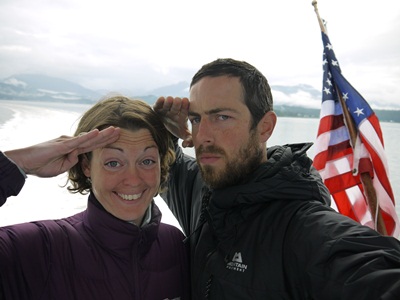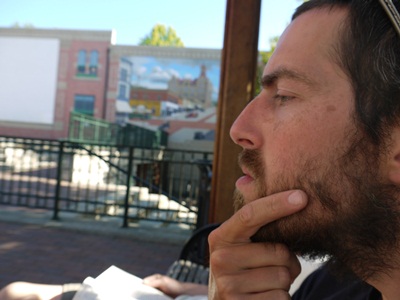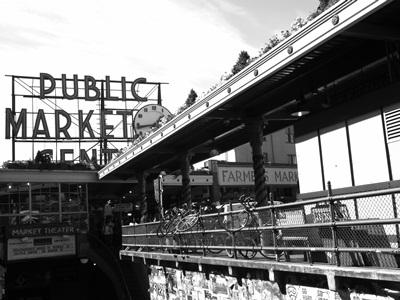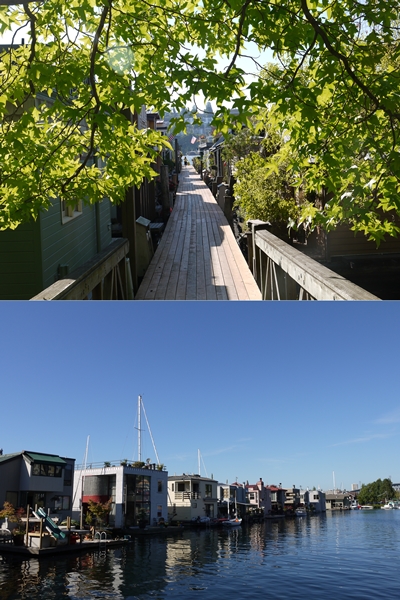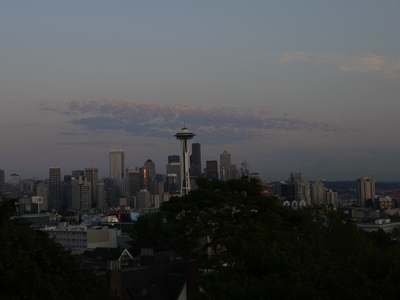Bearanoia – cycling in bear country
September 14th, 2011
With hindsight, perhaps watching the incredible documentary about Timothy Treadwell, Grizzly Man, wasn’t the best introduction to bear country. Treadwell thought he could talk to the bears – and he did for a bit. Then the bears ate him.
The motorcyclist set down his coffee cup and leant back in his chair, a slow smile spreading across his face. “Well, maybe I shouldn’t be tellin you this, but there was a Japanese guy ridin’ through here on a bicycle just like you two. A Grizzly got him – just knocked him off his bike and ate him all up. Good luck to y’all, that’s all I can say.”
It seemed every Alaskan we met had a bear tale to tell. I could never tell if there was a nudge and a wink behind our backs as they watched the naive tourists wriggle in their seats, but it became clear that however much the stories may have been exaggerated, there was a healthy respect for bears in the North. Everyone had their own nugget of advice for us, from the plausible to the hilarious (“Carry a tin of sardines in your pocket to distract a charging bear” was my favourite).
I certainly found it hard not to give in to a little creeping bearanoia. I spent one night frozen rigid in my sleeping bag, as a snorting grizzly prowled outside our tent just centimetres away. It was only the next morning when the ‘grizzly’ was still snorting that I realised it was in fact the toilet pump from a nearby campervan, and I had actually been listening to an elderly American making their 3am trip to the bathroom.
Here’s a selection of some of the bear advice we received, along with our own experiences.
1. Attach bear bells to your bike.
The theory: on a bike you are much stealthier than you would be in a car. By carrying a bear bell, bears will hear you coming and get out of your way.
In reality: We merrily jangled along for weeks sounding like Santa’s sleigh, confident every bear in the vicinity would be hear us coming (maybe that’s why it took us five weeks to see one). Then someone pointed out that bears are actually very curious, and in fact our jaunty bells did a great job of announcing that a very slow moving, nicely wrapped food parcel was on its way. A kind of slow moving ice cream van for bears if you like.
2. Hang all food and anything else with a strong smell up in a tree.
The theory: by hoisting all your food and toiletries high into a tree, no bear will have any reason to come knocking in the night.
In reality: I was by far the most odorous item in our tent, and there was no way I was climbing up a tree for the night. Even hoisting our food proved a serious challenge, as evolution clearly hasn’t selected Alaskan trees based on their food hanging potential. Most spindly Alaskan spruce looked like a bag of crisps might send them keeling over, let alone 10 days of food for two calorie starved cyclists. When we stayed on campsites, we found that stashing our food in the bear-proof rubbish bins was a far easier option.
3. If a bear charges you, don’t run.
The theory: If you are unlucky enough to be charged by a bear, stand your ground – otherwise the bear will get excited and think that it really has stumbled on something worth chasing.
In reality: We read pages of detailed advice on what to do in this situation; so much that we would probably need to ask the bear to stop mid-charge while we checked the manual. While your life flashes before your eyes, you also have to identify what type of bear is heading towards you, and work out what mood it is in. If it’s a ‘defensive charge’, then in theory the bear will either veer off or stop short at the last moment (and I imagine probably stick its tongue out and roll about laughing at the tourist having a coronary). If it’s an aggressive charge, then you’ll know about it. Your options then are to ‘play dead’ if it’s a grizzly, or ‘fight back’ if it’s a black bear. Good luck with that.
4. Carry bear spray.
The theory: Bear spray is the universally acknowledged weapon of choice when it comes to repelling a bear attack (other than a gun that is – and even then a grizzly’s forehead is meant to be so thick that bullets often just bounce off.)
In reality: It certainly makes you feel safer to have some kind of weapon at your disposal, but after reading the small print I’m not so sure. Firstly, if you fire off your bear spray into the wind, then chances are it’s going to disable you far more than the bear. Given that we spent most of our time in Alaska cycling into a headwind, this seems like quite a fundamental flaw. Secondly, I can’t help thinking that if you are lucky enough to hit your target, then a half-blinded bear is probably not going to be in a mood to slope off into the bushes. Chances are that if it was just a ‘defensive’ attack, by now you’ve definitely managed to turn it into an aggressive one.
Despite all the above, so far we’ve camped for more than 50 nights in bear country with no problems. In the end we have seen both grizzly and black bears, both magical experiences – but it took us over five weeks to do so. The reality is that, unless you’re really unlucky, bears don’t actively hunt people. Unsurprisingly, they’re far more interested in the feast of salmon and berries on offer than chasing scrawny tourists on bikes.
Coming from England, where animals tend to be cute and cuddly, it’s been at once disconcerting and exhilarating to suddenly find that you’re no longer at the top of the food chain. It re-ignites a primal survival instinct, long suppressed by the ease and comforts of modern life. Back home, you have to actively seek out wilderness, where humans haven’t imposed order over nature in some way. Here in Alaska, surrounded by wilderness, it is the other way round. You are entering the bears’ world, and you play by their rules. It seems it’s only really when humans interfere and break those rules (mentioning no names, Mr Treadwell), that things really go wrong.
James
The Inside Passage
September 20th, 2011
After weeks of cycling and wilderness and rain, taking ferries along the Inside Passage of SE Alaska offered us a rest and a chance to regroup and take stock of the cycling we had achieved so far. The time on and off the ferry proved to be challenging in its own way – more torrential downpours with a broken tent wasn’t quite the relaxation we had in mind, but it offered a chance to see a beautiful part of Alaska in a way we simply couldn’t have done on the bikes.
A selection below of some of the sights we saw along the way…what we can’t include are pictures of humpback whales – their tail fins disappearing before we even thought about getting the camera out – and pictures of just how heavy the rain got, but believe me, we were wet, seriously wet…those marigold washing up gloves mentioned in the last post did indeed get used and I can highly recommend them to anyone searching for a waterproof solution for their hands!
Sarah

Hanging right over our campground just outside our first ferry stop of Juneau, the Mendenhall Glacier is an impressive and chilly sight. We know from our maps that we passed by many glaciers as we cycled through Alaska but most were only visible and accessible by air, so it was a treat to have this one so close to our campground…
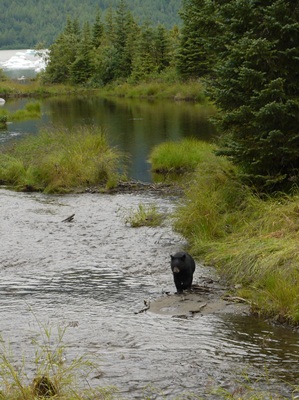
Our first sighting of a black bear…this young cub had his pick of the Sockeye salmon desperately trying to swim upstream to their final resting place; he did his part to ensure that at least some of them didn’t make it. Shortly after this picture, we watched him bag a monster fish and crunch his way through it.
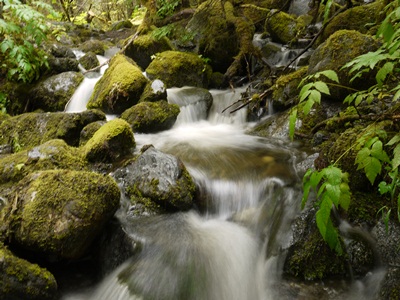
Through the rainforest and up a height to view the Mendenhall Glacier, we saw lots of beautiful icy clear waterfalls and dripping moss.

One of our stops on the ferry was at Sitka, a port occupied at various points in history by the Tlingit natives, the Russians, the British and the Americans. A mish-mash of history is everywhere; Russian street names and graveyards nestle alongside American tourist kitsch.

Treating ourselves to some local Alaskan fish was a good plan; this hole in the wall café served up the most delicious fish and chips.
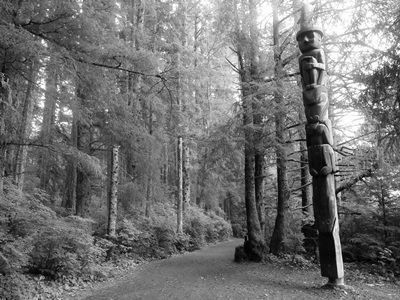
Marking the spot where native Tlingit people fought the Russians for control of Sitka is a beautiful totem park with totem poles dotted amongst the trees from where they were carved…very atmospheric and in fact one of the few places that possibly looked better with a bit of rain.
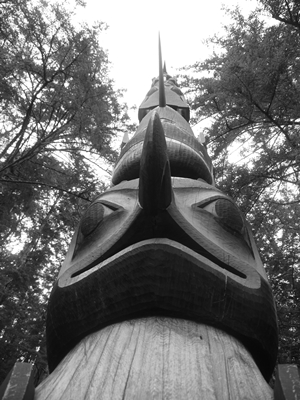
Looking up at the awesome carvings gives appreciation of how much work Native Americans put into telling their stories through wood.
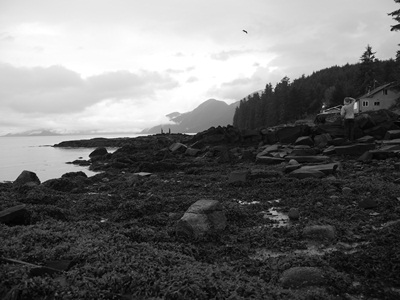
Next ferry stop was Wrangell, a sleepy town unaffected by cruise ship tourism and totally deserted on a rainy Sunday. Perfect time for us to walk on the beach and catch sight of two bald eagles close up.
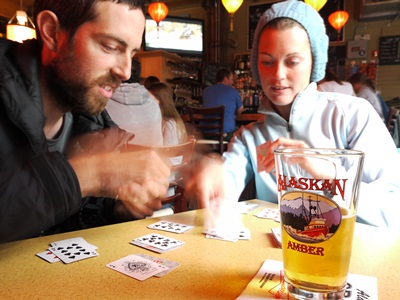
Ketchikan, our final ferry stop, proved to be the wettest. According to locals, there was record rainfall on precisely the two days we happened to be there. A great excuse to hide in a local pub and play cards then…

Bikes and cyclists totally dwarfed by one of the colossal cruise ships that we saw along the Inside Passage. Cruise ship tourists are now essential to the survival of these former fishing towns. For us, it was a culture shock to be confronted by all 2000 passengers disembarking in matching jackets with an Alaskan tick list of sights to see in half an hour.

A group of shots from our 36 hour ferry journey between Ketchikan and Bellingham. Sleeping out on deck under the stars, experiencing our first proper sunshine for over three weeks, seeing whales and watching the sun rise were all fantastic highlights of a great trip.

Sun rising as we approach Bellingham and the moon’s still out too. A beautiful end to a great Alaskan adventure.
Sleeping in Seattle
September 22nd, 2011
A bed. Sunshine. A roof over our heads. A new tent. A new knee (well, a repaired one at least). Mouth-watering food that didn’t start with a ‘p’ (peanut butter, porridge, pasta). Our two and half weeks in Seattle were the perfect city break; a chance to put down roots just briefly, pause and get ourselves set for the next stage of the adventure.
Best of all, it gave us the chance to spend time with my aunty Junie Liz and my cousin Barbara – probably longer than I’ve spent with them in the past 30 years combined. They looked after us like royalty, and it was hard to tear ourselves away.
James
Here’s just a snapshot:
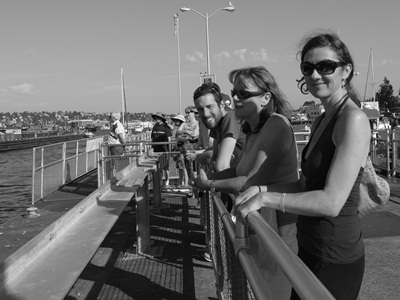
Barbara oriented us with a fantastic alternative Seattle tour. We took in the Ballard Locks, where boats queued to head back into Lake Union after a day soaking up the sun in the Puget Sound…
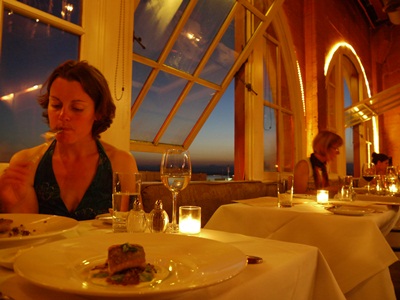
For once, we’re not begging your food sympathy – thanks to a leaving present from my former workmates at Challenge for Change, we feasted at Chez Shea, a great french brasserie overlooking Pike Place Market. One to be savoured for many months to come.

Across the water to Junie’s beautiful house and garden at Port Orchard – early morning coffee on the deck with a view back across to the city…
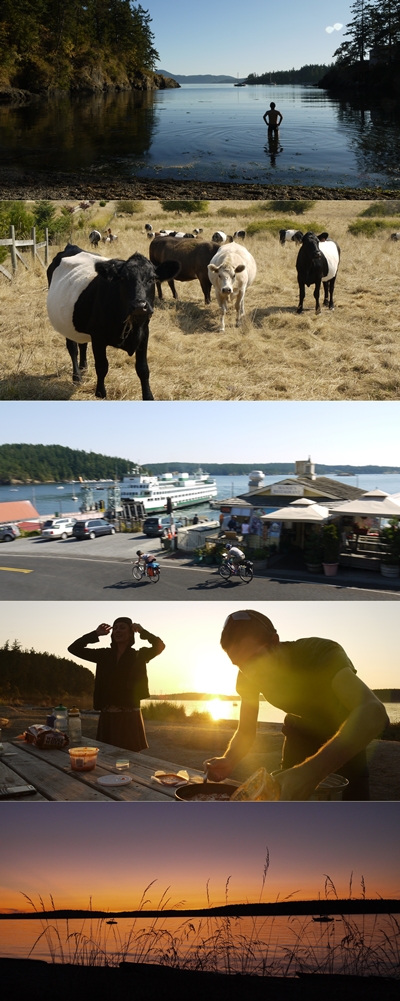
We stripped down our panniers and spent our final weekend touring the bike-friendly San Juan islands with B. It was bike touring bliss: ferry hopping between islands, great camping, and at the Doe Bay resort even hot tubs to soothe tired legs in the evening.

Having missed Vancouver on the way down, we jumped on a train with our bikes for a flying overnight visit before we headed south – and were not disappointed. City beaches, mountains all around for weekend outdoor escapes…

…plus of course a good network of bike routes – no wonder it keeps topping the polls for being one of the world’s most ‘liveable’ cities.

Thanks to Jess and Robbie for hosting us – and for pointing out where we could find the best Chinese steamed buns in the city!

